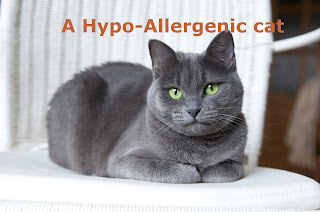A Hypo-Allergenic cat - Best Pets 4 Home
A Hypo-Allergenic cat?
Some people may be interested in the Russian Blue cat because they have heard of the breed’s ‘hypoallergenic’ qualities.
A Hypo-Allergenic cat
Hypoallergenic means ‘causes less allergic response’. This does not mean that it causes none. For an allergy sufferer, there can be many triggers, and these will vary between each individual. Cat allergies can be caused by allergens in dander, cat fur, and the most widely known: Fel-D1, which is a protein contained in the saliva and sebaceous glands of the cat. As the cat’s saliva and sebum dries on the hair, it can then flake off and become airborne. If Fel-D1 is inhaled, the body will produce histamine in the respiratory system, causing the nose and throat to itch and swell which can, in turn, cause breathlessness and wheezing, along with tearful eyes and other itching or rash development.
There are different levels of allergic responses. Some people will become acclimatized to their own cat(s), and gradually, over a period of several weeks, their bodies will cease to respond, bar the odd sneeze if the allergen levels rise above their tolerance levels. This type of allergic response can return if they are not exposed to the familiar allergens for a period of time. For example, a child may well live happily with a cat, but then on return from University (or boarding school), may find that their body responds to their home cat with a huge allergic response. Sometimes it is possible to reduce the allergen levels within the family home, but sometimes it is not possible to desensitize the person to their cat again, and they are forced to live without their beloved pet. One researcher found that Fel-D1 was found in extremely high concentrations on office chairs and in school classes and corridors. Neither are feline environments, but both are places where cat-owners congregate, topping up the levels of the protein every day as they carry it in on their clothes.
Fel-D1 levels are higher in un-neutered than neutered males, and so has been linked to the production of testosterone. It is debated whether levels would vary between neutered males, females, and neutered females. Having researched the subject ourselves, and using Jon’s background in breeding and genetics, we would surmise that testosterone (and thus, Fel-D1) levels would be similar in neutered animals of both genders since neither will be producing testosterone. All kittens are supposed to be Fel-D1 free, as they do not produce testosterone or Fel-D1. However, their mother (who licks them) will be producing significantly higher levels of Fel-D1, since it is her biological prerogative to ensure their survival, and fight off any threatening males. Feline social research has shown that breeding queens with kittens will socially out-rank the local Romeo. –They may be his kittens, but if in doubt, she will fight him off with alacrity, to ensure that her offspring survive. Again, although kittens are meant to be Fel-D1 free, with our biological background, Wychwood would argue that kittens are coated with their mother’s Fel-D1 protein and therefore are a good way of checking allergenic responses.
Excellent hygiene is one way of reducing or maintaining the protein to manageable levels, and a good vacuum cleaner with a HEPA allergen filter is a worthy investment. It is worth bearing in mind how sticky Fel-D1 is and hiring a carpet-cleaning machine, and using it with hot water and detergent is something that we do in our home as part of the process of keeping our home hygienically clean and odor-free. Solutions such as PetalCleanse and upholstery sprays like Febreze Allergen Reducer can keep the protein from becoming airborne. It is also worth considering what other allergens may be lurking in the cat owner’s home, and some sufferers respond well to different cat litters. The main factor with litter is that it should not cause airborne dust to waft around when you are dealing with the litter tray. We will help as much as we can to ensure a successful outcome to this particular issue, but a clumping litter would seem a necessary choice, as it completely contains liquid waste in an easily scoopable ball. I wonder if a dust mask, such as those which you can now buy in the D.I.Y. stores would help at litter changing times? And disposable gloves would seem to be a useful tool in the arsenal of a committed cat-loving allergy sufferer. Also, consider one of the lock-it-away litter bins, and wrap all of the waste in “nappy sacs” before it goes into the “Litter Locker” type bin. This will reduce smells and waste handling. For a single cat home, you might prefer to flush the solid waste down the toilet and wrap and bin the clumps of wee.
The Russian Blue Cat
Despite its thick double coat, the Russian Blue cat sheds very little fur. This means that there is less build-up of loose fur and Fel-D1 in the environment. Selfishly, it also means less fur on the furnishings and furniture, which is lovely for us, the owners! There have been surveys done in America, which show that some Russian Blue cats have a lower Fel-D1 count than other breeds, including moggies. In fact, moggies have some of the highest Fel-D1 counts around and cause the most allergic reactions. Presumably, Fel-D1 was not such a biological necessity in the depths of Russia, because the breed that has the world’s record for lowest levels of Fel-D1 is the Siberian cat.
We have had mixed success with allergy sufferers and must stress the importance of visiting the cats that you wish to adopt. Check whether you react to the mother and the kittens, and check whether the breeder has fur samples which you can test on your skin to see if a rash develops.
The vast majority of our feline allergy visitors have reported past asthma attacks or breathing difficulties as part of their normal range of reactions to cats. Our visitors have stayed in our home on average for three hours, to see how they react and whether their symptoms develop. They report that their symptoms remain fairly stable, whilst experiencing itchy eyes and runny noses, which is of course uncomfortable and unpleasant.
Families with young children must consider very carefully the welfare and health of their little ones. We have been approached in the past by prospective parents who both have feline allergies and who wanted a pet cat to ensure that their children did not suffer the same allergies as they did. Whilst they presented a perfectly reasonable and logical argument in favor of adopting a pet Russian Blue, I refused to put their soon-to-be-born baby at such potential risk of allergic reaction or even worse, considering that both parents are allergy sufferers.
Some resources which we recommend are the wonderful National Eczema Society, which has a free helpline with fellow sufferers whom you can speak to about your pet allergies. I telephoned them and they have sent me a Pet Information Pack and were very helpful with advice about breathing difficulties as well.
One of our families trialed the new Cat Vaccine during 2012 with positive outcomes, and Circassia is planning to release a better vaccine in 2016.
The main recommendation is to bathe your cat every week, to reduce the levels of Fel-D1 on its coat, but there are several products which seem to have helped to control the level of allergens in your home. a






